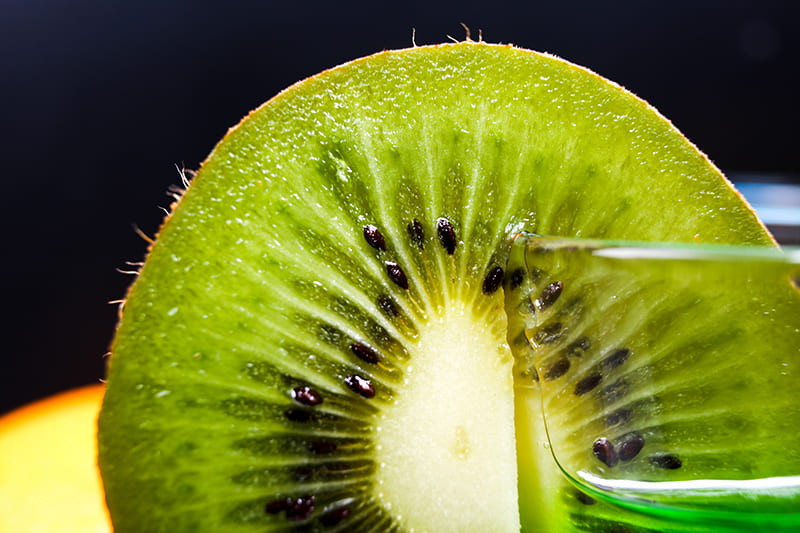Kiwi is more than just a tasty fruit; it can play a role in making teeth appear whiter naturally. Its natural enzymes and high vitamin C content help break down stains on the teeth’s surface and support gum health, leading to a cleaner, brighter smile over time. This makes kiwi a gentle, food-based option for those looking to avoid harsh chemicals.

However, kiwi’s acidity means it should be used carefully to avoid damaging tooth enamel. Combining kiwi with other natural ingredients, like cucumber or baking soda, can enhance its whitening effects while reducing potential enamel wear. Understanding how kiwi works and the right way to use it is key to safely improving tooth brightness.
Many people want safer, simple ways to whiten teeth at home. Kiwi offers an interesting approach for those seeking natural alternatives. Learning about its benefits and best practices can help anyone considering a natural teeth-whitening method.
Key Takeaways
- Natural enzymes in kiwi help reduce teeth stains.
- Careful use is important to protect tooth enamel from acidity.
- Combining kiwi with other ingredients can improve whitening results.
Understanding Tooth Discoloration

Tooth discoloration happens for different reasons, ranging from habits to the types of foods people eat. Some causes are related to surface stains, while others affect the deeper layers of the teeth. Natural methods can help reduce mostly surface stains and improve tooth color.
Common Causes of Tooth Staining
Stains on teeth often come from everyday habits like drinking coffee, tea, or red wine. Smoking cigarettes also causes dark stains. Some stains form on the outside of teeth (extrinsic), while others happen inside the tooth (intrinsic) due to aging or medications.
Poor oral hygiene lets plaque and tartar build up, which can make teeth look yellow or brown. Illness or fluoride overdose early in life can also cause discoloration. Physical trauma to teeth sometimes causes dark spots that don’t go away with cleaning.
Natural Solutions for Whitening
Natural whitening usually works best on surface stains. Some fruits produce enzymes that break down stains. For example, kiwi contains actinidain, an enzyme that can help remove dental biofilms and plaque buildup. This helps reduce tartar and can brighten teeth over time.
Other natural methods include brushing with baking soda or using hydrogen peroxide rinse in low concentrations. Avoiding acidic juices often helps protect enamel from wearing down, which keeps teeth stronger and less discolored.
Foods That Affect Tooth Color
Certain foods are known to stain teeth if eaten often. These include:
- Dark berries like blueberries and blackberries
- Red wine and coffee
- Soda and cola drinks
- Dark leafy greens and beets
On the other hand, some foods can aid in reducing stains. Kiwi’s citric acid gently helps erase surface stains without damaging enamel when consumed in moderation. However, too much acid from lemon or kiwi juice can wear down enamel, leading to sensitivity and more discoloration if not balanced properly.
For more detailed information on kiwi’s role in cleaning teeth, see teeth friendly fruits like kiwi details.
Kiwi’s Natural Whitening Properties
Kiwi contains elements that can affect teeth color and health in several ways. Its acids, vitamins, and antioxidants each play a distinct role in how it interacts with the teeth and supports oral hygiene.
How Kiwi Interacts With Tooth Enamel
Kiwi has citric acid, which can gently help remove surface stains while eating. This mild acid works by breaking down stain particles on the enamel but does not usually cause strong effects. However, too much acid can wear down enamel over time, which may increase tooth sensitivity.
It is important to balance kiwi consumption to avoid enamel erosion. Brushing teeth after eating kiwi or rinsing the mouth with water can help protect enamel.
Vitamin C and Enzyme Effects
Kiwi is rich in vitamin C, which supports gum health and helps reduce inflammation in the mouth. Healthy gums are key to maintaining overall dental health and a brighter smile.
The fruit also contains enzymes that may contribute to breaking down leftover food particles and bacteria. These natural enzymes assist in cleaning the mouth, potentially reducing plaque buildup and helping teeth appear cleaner.
Antioxidant Benefits for Oral Health
Kiwi’s antioxidants combat harmful free radicals inside the mouth. These antioxidants protect gum tissues and cells from damage caused by bacteria and environmental stress.
By reducing oxidative stress, antioxidants in kiwi help maintain stronger gums and oral tissues. This support indirectly contributes to tooth whiteness by promoting a healthy oral environment where fewer stains and infections occur.
Learn more about kiwi’s effects on teeth at nthdegreeorthodontics.com.
How to Use Kiwi for Whitening Teeth
Kiwi can be used in simple ways to help reduce stains and clean teeth. It often works best when combined with other natural ingredients. Users should follow clear steps and pay attention to how often and safely they apply it.
Preparation and Application Methods
To prepare kiwi for teeth whitening, mash two slices of kiwi until smooth. Some people mix this with cucumber slices and a small amount of baking soda to increase cleaning power.
After mixing, apply the paste to a soft toothbrush. Then, gently brush the teeth with it for about 1-2 minutes. Avoid scrubbing too hard to protect tooth enamel.
Rinse the mouth thoroughly after brushing to remove any leftover fruit acids. The kiwi’s enzyme, actinidin, helps break down surface stains but needs direct contact with teeth for best results.
Recommended Frequency and Safe Use
It is best to use the kiwi mixture no more than twice a week. Frequent or daily use might damage the enamel because of its acidic content.
Waiting at least three days between treatments helps teeth stay strong and prevents sensitivity. After each use, brushing with regular fluoride toothpaste adds protection.
Users should keep sessions short, about 2 minutes, to avoid overexposing teeth to acids and enzymes. Sticking to recommended frequency helps balance whitening effects with enamel health.
Precautions and Potential Risks
Kiwi contains natural acids that, if used too much, can wear away tooth enamel. Losing enamel leads to increased tooth sensitivity and decay risk.
People with sensitive teeth or existing dental issues should avoid using kiwi as a whitening method without dentist advice. Some may experience mild gum irritation from the fruit’s acids.
Always rinse the mouth well and do not swallow the whitening paste. If any pain, discomfort, or lasting sensitivity occurs, discontinue use and consult a dental professional. More details about mixing kiwi safely can be found in this TikToker’s guide to whitening teeth with kiwi.
Comparing Kiwi With Other Natural Whiteners

Kiwi offers unique properties for teeth whitening compared to other natural options. Its enzymes and acids work differently than strawberries, pineapple, or baking soda. Combining kiwi with other fruits can also change how well it cleans teeth.
Kiwi Versus Strawberries and Pineapple
Kiwi contains actinidain, an enzyme that helps break down dental biofilms, which can reduce tartar buildup. Strawberries and pineapples also contain natural acids and enzymes, like malic acid and bromelain, that may help remove surface stains.
However, kiwi’s action is gentler on enamel compared to the stronger acids in strawberries and pineapples. This means kiwi may whiten teeth with less risk of enamel erosion.
Still, none of these fruits offer dramatic whitening on their own. They can best support oral hygiene when used regularly but carefully to avoid enamel damage.
Efficacy Compared to Baking Soda
Baking soda’s abrasive nature physically removes stains from teeth surfaces. It provides a faster and more noticeable whitening effect compared to kiwi.
Kiwi relies on enzymes and acids for gradual stain reduction, which is less abrasive and safer for enamel. Baking soda can sometimes cause sensitivity if used too often.
Using kiwi may be preferable for those with sensitive teeth. Baking soda remains a widely recognized natural whitening agent but should be used with caution to prevent enamel wear.
Synergistic Effects With Other Fruits
Some people combine kiwi with fruits like cucumber or use baking soda to boost whitening effects. Kiwi’s enzymes may help soften plaque, allowing other ingredients to be more effective.
However, mixing acidic fruits can increase enamel erosion risk, especially with frequent use. For example, kiwi and lemon juices together can damage enamel faster than using either alone.
It is important to balance the benefits of combined natural ingredients with the risk of harming tooth enamel by overusing acidic treatments.
Lifestyle Tips for Maintaining Whiter Teeth

Maintaining whiter teeth depends on making smart choices in daily life. This includes what a person eats and how they care for their teeth. Both play important roles in keeping teeth clean and reducing stains.
Dietary Choices That Support Whitening
Eating certain foods can help maintain whiter teeth. Fiber-rich fruits like kiwi clean the gums and teeth naturally by increasing saliva flow. This helps wash away food particles and bacteria.
Avoid drinks and foods high in acid or strong color, such as soda, wine, and coffee. Acidic foods can wear down enamel, making teeth more sensitive and prone to staining. It is best to rinse or brush teeth after consuming these.
Including calcium-rich foods like dairy or leafy greens strengthens tooth enamel. Strong enamel is less likely to stain or erode. Drinking water throughout the day also helps keep the mouth clean and supports natural whitening.
Oral Hygiene Best Practices
Consistent oral hygiene is key for whiter teeth. Brushing twice daily using fluoride toothpaste removes surface stains and prevents plaque buildup. Flossing once a day cleans between teeth where brushes can’t reach.
Using a soft-bristled toothbrush avoids damaging enamel and gums. Gentle brushing with circular motions is more effective than harsh scrubbing. Avoid whitening treatments during orthodontic care to prevent damage.
Regular dental cleanings are important. A dentist can remove stubborn stains and check for any oral health issues. Combining good hygiene with healthy eating supports long-term tooth color and health.
For more on how kiwi can help naturally lighten teeth, see kiwi’s effects on gums and enamel.
Frequently Asked Questions

Kiwi contains Vitamin C and calcium, which help protect and strengthen tooth enamel. It also supports the natural removal of stains, contributing to a healthier and brighter smile.
How can kiwi contribute to oral hygiene?
Kiwi’s Vitamin C helps protect tooth enamel from erosion and fights bacteria that cause decay. Its natural fibers also aid in cleaning teeth by gently scrubbing away plaque.
What are the benefits of using fruits for teeth whitening?
Fruits like kiwi provide vitamins that strengthen teeth and gums without harsh chemicals. They also contain natural acids and fibers that help break down surface stains on teeth.
Which natural ingredients promote the fastest teeth whitening?
Ingredients such as Vitamin C-rich fruits, baking soda, and activated charcoal are known for their quicker whitening effects. Kiwi’s high Vitamin C content supports enamel health, which helps teeth look naturally lighter over time.
Are there any risks associated with using kiwi for dental care?
Using kiwi in moderation is generally safe, but excessive exposure to its natural acids could weaken enamel if not balanced with proper oral hygiene. People with sensitive teeth should be cautious.
How often should one use kiwi for teeth whitening to see results?
Eating or applying kiwi regularly—several times a week—can gradually improve tooth color. Consistency is key, as natural whitening is slower than chemical treatments.
Can kiwi be used in conjunction with other natural teeth whitening methods?
Yes, kiwi can be combined with other natural methods like oil pulling or brushing with baking soda. This combined approach can enhance oral health and support a brighter smile.
Interesting Links
Social Media
Instagram: https://www.instagram.com/newofficialwellness/
Facebook: https://www.facebook.com/people/Well-Health-Guide
Youtube: https://www.youtube.com/officialwellness

